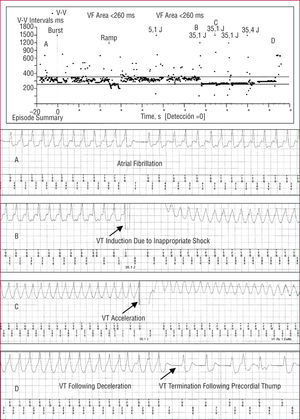A 70-year-old patient with dilated cardiomyopathy and severe ventricular dysfunction underwent implantation of an implantable cardioverter defibrillator (ICD) following an episode of syncopal sustained monomorphic ventricular tachycardia (VT). During the follow-up, she presented an episode of syncope while at her health care center. She was attended by a physician who, upon confirmation that the patient was unconscious and had an almost imperceptible pulse, performed a precordial thump. Subsequently, the patient recovered and was sent to the hospital. ICD interrogation showed that she initially had an episode of atrial fibrillation (A) that was detected by the device as VT and was treated (inappropriately) with antitachycardia pacing (burst and ramp), a 5.1-J cardioversion shock, and a 35.1-J defibrillation shock. This last discharge induced syncopal VT (B) which, following a new 35.1-J shock, presented slight acceleration to faster VT (C) and posterior deceleration after another 34.4-J shock (D). The device had unsuccessfully exhausted the maximum energy shocks and finally, the arrhythmia ceased with the precordial thump (D).
Proarrhythmia is the induction of cardiac arrhythmias (both tachycardia and bradycardia) by therapies (antitachycardia and/or antibradycardia) programmed in the ICD, in the presence or not of spontaneous arrhythmias.
The example presented illustrates 3 types of proarrhythmias in a single case: VT induction by inappropriate therapy for atrial fibrillation, VT acceleration following appropriate therapy, and posterior deceleration with another appropriate therapy.
Figure.


